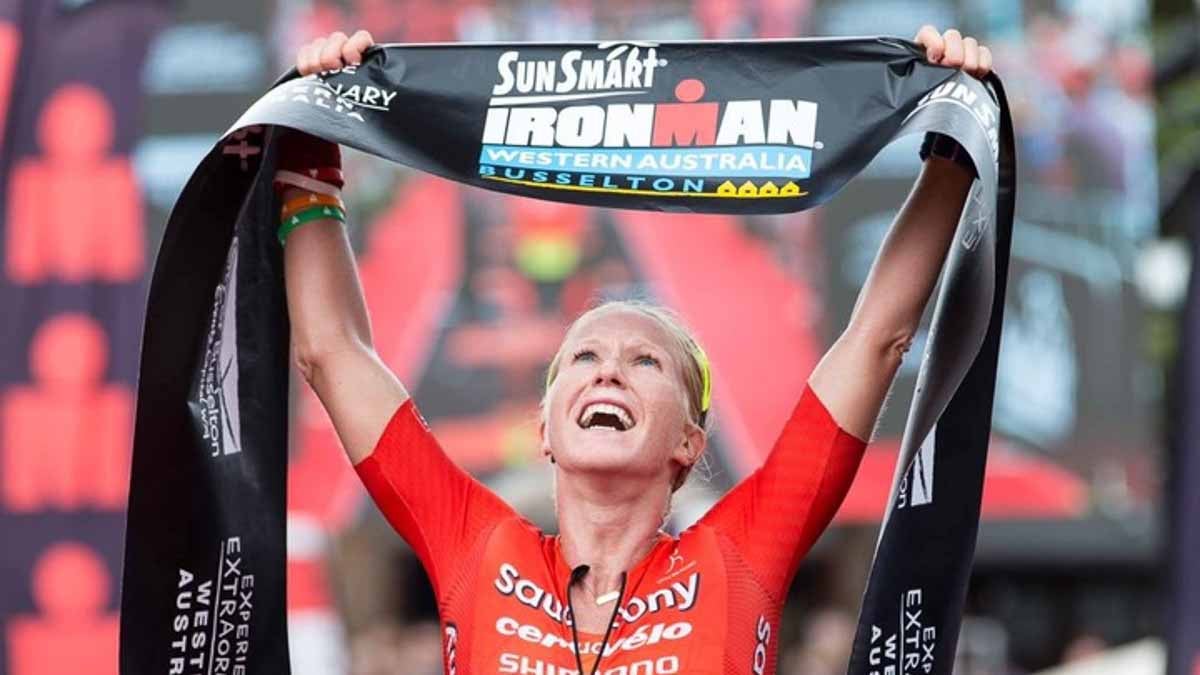Ironman triathletes ride the fine line between healthy and risky exercise
Listen
Sarah Piampiano is the third ranked female qualifier in the world for the Ironman championship in Kona
For a handful of triathletes training in a pool in the suburbs of Kansas City, simply swimming laps is too easy.
Instead, they’ve got their legs constricted so their arms do the work of dragging their bodies through the water.
The area is an Ironman triathlon training destination for reasons that might surprise the locals. Triathlete Sarah Piampiano says she comes here because Kansas in late summer is a lot like… Hawaii.
“The environment here is actually fairly similar to the type of environment that you get in Kona in terms of the heat and humidity and wind and also the type of terrain that’s here,” Piampiano says.
But Piampiano isn’t here for any luau.
The San Francisco athlete is the third ranked female qualifier in the world for the Ironman championship in Kona, which takes place on Saturday, Oct. 8.
She lives her life in cycles of training and recovery, and that includes weeks prior to the event in a particularly intense routine that pushes the limits of what the human body is capable of.
“Yesterday I had a double ride and a run,” she says. “So in the morning I did a two and half hour ride with six by eight minutes intervals. And then immediately off the bike, I got my running stuff on and did a 30 minute run where I did five rounds of one minute at a five-minute, 30-second per miles pace.”
That’s just one day. Over a week, her regime adds up to around 350 miles of cycling, 50 miles of running and 25 miles of swimming. She has to eat even when she’s moving to get between seven and nine thousand calories a day.
It doesn’t stop just because she does. Piampiano’s sleep, which starts between 7 and 9 p.m. each night, is also carefully tracked by her coach.
“It may seem nice and relaxing to have your feet up and be on the couch and going to bed early, but it is structured and there is quite a bit of pressure around it as well,” she says.
This is a long way from the life she first set out on. The 36 year old, who goes by the nickname ‘Little Red,’ was once a mergers and acquisitions banker on Wall Street and had an adrenaline-fueled lifestyle to match.
“I was smoking one-to-two packs of cigarettes a day,” she says. “I was going to bed late. I was partying with my friends all the time. I didn’t get much sleep. I wasn’t eating very well, and on a bet with a friend, I ended up going and doing my first triathlon.”
Since leaving banking behind to go pro in 2012, her life has become almost monastic by comparison. She says it can seem ridiculous even to her at times.
“I sleep. I eat. I train. I eat. I sleep. I train. I eat. I sleep. I train,” she says with a laugh.
It’s easy to imagine her life is the pinnacle of health. But that’s debatable.
Triathlon coach Ken Welsh works with everyone from first-timers to Kona-level contenders.
“I often joke with people. I say, ‘Doing triathlon’s a healthy lifestyle. Doing the Ironman kinda tips over that edge a little bit,'” Welsh says.
Since getting involved with triathlons in the mid-’90s, he’s watched an explosion of interest in the sport, particularly in the Ironman, which is about four times the length of an Olympic triathlon.
He says successful triathletes are often type-A personalities like Piampiano, who refuse to take ‘no,’ even if it’s coming from themselves.
“Your body’s like ‘Forget this, I’m done.’ And half your brain’s going, ‘Yeah, we agree with the body: stop, stop, stop!’ And the other half’s going, ‘Come on! You trained for this!'” Welsh says.
For mere mortals, a cross training routine of running, swimming and cycling would usually be considered safer than focusing on a single sport, but studies show that triathletes get hurt at least as often, if not more, than pure runners, because of the intensity and sheer volume of training they do. That’s especially true for newcomers.
But there’s a more insidious danger: overtraining syndrome.
Scientists are still trying to understand exactly how it effects the body, but David Neiman, Professor of Health and Exercise Science, and Director of the Human Performance Lab for Appalachian State University at the North Carolina Research Campus in Kannapolis, North Carolina, says overtraining syndrome largely involves the immune system.
Any time we do serious exercise, we suffer tiny routine injuries, and that triggers the immune system to jump into action.
“It goes in to actually engulf and actually take away some of the debris, some of the proteins that have escaped from the ruptured muscle cells,” Neiman says. “And then there’s a big repair process and inflammatory process that goes on until everything’s back to normal.”
He says that when athletes don’t get enough recovery, the immune system gets overwhelmed, and that can short circuit regulation systems throughout the body.
Not just the immune system, but the brain and hormones, leaving athletes exhausted, sick and depressed.
The push-through-it strategy of some triathletes can make things a lot worse.
“We have cases where it can take two or three years to get over it,” Neiman says.
The bright side of so many people getting into Ironman and other extreme endurance sports is that it gives researchers more opportunities to study overtraining syndrome.
That research has lead Neiman to think that these events are probably best left to the rare genetically gifted specimens among us.
“These very lean, light-framed individuals – they manage this a lot better than the 98, 99 percent of the rest of humanity,” he says.
Even within that elite group, recovery isn’t something to brush off. Sarah Piampiano admits she didn’t realize how demanding the cycles of both training and recovery would be.
She recognizes many newcomers who aren’t as serious as they should be about the yin and yang of the sport.
“You can see people with this phenomenal talent who are either emotionally immature or get injured quite frequently, and they don’t end up thriving in the way that their body has the potential to thrive,” she says.
But instead of slowing her down, she now looks at the long-game balancing act as a test of greatness.”And then you see other athletes who aren’t necessarily as strong of athletes per se, but they’re just so smart in their training and how they execute in races and some of them are world champions.”
WHYY is your source for fact-based, in-depth journalism and information. As a nonprofit organization, we rely on financial support from readers like you. Please give today.



